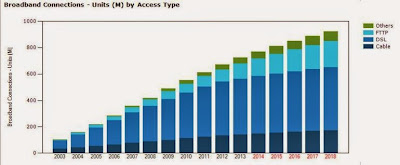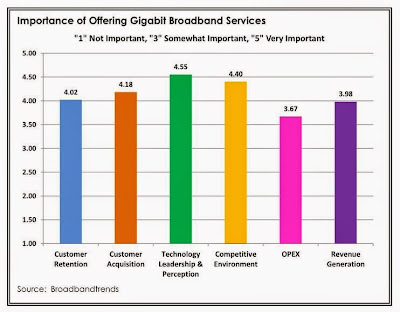“In
many countries, doing nothing is not an option any more in my opinion. In
particular, this is true where there is significant coverage and competition
from cable companies, who I expect to be embarking on another upgrade over the
next few years that will enable them to support 1Gbps services....We are also
likely to see some fiber to the home”
Ovum analyst Kamalini
Ganguly commenting on the development of G.fast upgrade that enables ADSL to
deliver Broadband speeds of up to 10 Gbps
Telecom
Provider LIME may have one more trick
up their sleeve after all as it relates to ADSL (Asynchronous Digital
Subscriber Line) as ADSL gets to Die Another Day. Queue the song Die Another Day by
Madonna.
In
fact, they may not even need to launch FTTH (Fiber to the Home) after all as I’d
predicted in my blog
article entitled “CWC
invests US$250 million in LIME Jamaica - Mobile 4G LTE, Broadband, LIME TV and
FTTH Expansion will make LIME the Google of Jamaica”.
During
the week of Sunday October 19th 2014, several Telecom Providers
announced at the Broadband World Forum in Amsterdam that they'd be putting a
new Technology called G.fast to the test to enable ADSL Lines with 1 Gbps
Speeds by 2016 as stated in the article “Lowly
DSL poised for gigabit speed boost”, published October 21, 2014 6:15 AM PDT
by Stephen Shankland, CNET
News.
Already
Telecom Equiptment suppliers Broadcom, China-based Triductor Technology and
Israeli startup Sckipio are making DSP (Digital Signal Processors) that support
the VDSL (Vectoring Digital Subscriber Line) Technology that makes G.fast work.
Already Sckipio has plans for testing its DP3000 chip for DSP in DSLAM and its
CP1000 chip for the CPE i.e. Gigabit ADSL modems by 2016.
G.fast
is a protocol still in development with pair of ITU (International Telecommunication
Union) ITU-T
G.9700 and ITU-T G.9701 still being in development. It has the potential to
ramp up Broadband Speeds on ADSL up to as high as 10Gbps as reported in the article
“G.fast:
1 Gigabit per second DSL”, published July 14, 2014 21:14 GMT (14:14 PDT) by
Steven J. Vaughan-Nichols, ZDNet.
 |
Once
ratified, it’ll offer speeds comparable to FTTH such as Google Fiber, AT&T
U-Verse and Verizon’s FiOS as described in my blog article entitled
“Gig.U
Third Annual Report - Google Fiber's American Gigabit Internet Revolution as
Jamaica starts Broadband Internet Revolution” which ADSL has long been
competing against.
But
clearly Broadcom is excited, based on the tone of Broadcom Senior Director of
Product Marketing Jim McKeon, who apparently has already found buyers for the product,
quote: “We think it's very competitive relative to the alternative of deploying
fiber. We believe we are going to be the first to market with this. We're very
excited for the potential for G.fast to unlock the hidden value of existing
copper plant that is distributed worldwide for DSL”.
So
how exactly does VDSL work?
ADSL gets G.fast
Upgrade to 1Gbps - Superfast Squelching upgrade requires Customers come closer
How
it works is really simple!
ADSL
uses high frequencies to carry Data over old Twisted Pair Telephone Wires typical
found in POTS (Plain Old Telephone Systems). The problem is that there is a
limit to how high the frequencies can go to increase Bandwidth and carry more
Data, as beyond a certain frequency, the Twisted Pair Telephone Wires begin to
experience what's referred to as Skin Effect, where the outer layers of the Wire
heat up due to the higher frequencies travelling through them.
Line
conditioning such as reducing the capacitance and inductance on the Twisted
Pair Telephone Wires helps to mitigate against this effect. But once outside in
the 600 pair Copper cables used to carry the multiplexed Telephone signal, the
cross-interference coupled with EMI (Electro-Magnetic Interference) will severely
degrade the ADSL Signal.
For
this reason, customer’s Landlines are assessed to see if the level of noise on
the Twisted Pair Telephone Wires is low enough to accommodate. In some cases,
the Twisted Pair Telephone Wires may be individually wrapped in flexible
metallic conduit that earthed to reduce the cross-interference from other Twisted
Pair Telephone Wires inside of the DSLAM. The DSLAM itself may even be air-conditioned
and cooled so as to reduce the effect of localized heating due to the Skin
Effect on Twisted Pair Telephone Wires.
Finally
customer have to live within 200m of the DSLAM (Digital Subscriber Line Access
Multiplexer), which is what multiplexes the Internet onto the customer's Landline
so that the ADSL Modem, which is the CPE (Customer Premises Equiptment) can
filter and separate the Analog voice channel multiplexed with the Data Channel
at a higher frequency.
With
G.fast, a new technique called Vectoring is basically traditional ADSL with an additional
firmware and hardware update to the ADSL that keeps track of what Data is being
multiplexed onto each Landline inside of the DSLAM Cabinet.
At
the higher frequencies required for 1 Gbps speeds, those higher frequencies
will cause self-interference within the cabinet that Twisted Pair Telephone Wires
shielding cannot resolve unless the Twisted Pair Telephone Wires were shielded
with a braided Cylindrical Earth Wire shield like Coaxial Cable.
That,
in case you're wondering, is why Triple Play Provider FLOW can provide high
speed 100MBps Internet and VAS (Value Added Services) such as Hosted PBX as
explained in my blog
article entitled “FLOW
rolls out Hosted PBX - How 100 MBs FLOW Ultra can power a Private WiMaX
Community Network” without worrying about cross-interference inside of
their cross-connection cabinets.
G.fast with Fiber Optic
Backhaul – DSLAM cooled and Twisted Pair Telephone Lines shielded
Because
the Twisted Pair Telephone Lines are not shielded, vectoring basically uses
this knowledge of what's being transmitted on each Twisted Pair Telephone Wire and
the DSP algorithm to predict the pattern of interference from nearby Twisted Pair
Telephone Lines inside the DSLAM Cabinet.
It
then squelches out the interference, thereby allowing the transmission of super
high speed Data at speeds nearing 1 Gbps. I say “nearing” as in reality you’ll
probably see speeds of say 950Mbps as vectoring can only squelch out noise
inside of the DSLAM Cabinet not outside. Also you can only get the full 1 Gbps
if you live within 50m of the DSLAM or the Telecom Providers Exchange.
 |
Since
that's not going to be practical, a solution has to be found. That solution is
the use of Fiber Optics as backhaul to carry High Speed Data to the DSLAM
Cabinet, bringing it closer to the customer! Makes sense as ADSL already
installed and it’s cheaper to upgrade than to buy new equiptment for FTTH.
Technology Leadership
as important as pricing - ADSL to Die Another Day as G.fast makes 1 GBps
Internet possible
Telecom
Providers such as LIME will use Fiber
Optics to extend their DSLAM range by bringing the high speed data to the DSLAM
to be multiplexed inside of the DSLAM Cabinets with the Analog voice on the Twisted
Pair Telephone Lines, like traditional ADSL.
Only
this time with the Hardware and firmware updates for DSL, they'll be able to
carry speeds of up to 1 GBps instead of just 8MBps, the current maximum for LIME ADSL as noted in my blog article
entitled “LIME
rolls out new Business themed ADSL and Local and International Landline Calling
Bundles - DigiHome offense could Herald the coming of LIME FTTH and relaunch of
LIME TV”.
Because
its will now be within the required 50m, the rest of the line to the customer’s
premises can be conditioned i.e. individually wrapped in flexible metallic
conduit so as to further reduce external EMI.
With
other Technologies requiring the installation of new Infrastructure, this
firmware and hardware upgrade couldn’t have come at a better time, lending a
new lease on life for ADSL which was
designed to be free at one point as predicted in my blog article
entitled “LIME
goes FTTH like Verizon's FiOS - Free ADSL after FTTH Mass Adoption”.
 |
Telecom
Provider LIME doesn’t have to invest in
any significant amount of New Hardware, just a few firmware and Hardware
upgrades in the form of circuit packs to upgrade the DSLAM and ADSL Modems to
process the higher speeds. Being a leader in High speed Data Technology is just
as important as pricing according to the BroadbandTrends
Survey among eighty eight (88) Telecoms Providers.
The
DSLAM Cabinets will have to be retrofitted with Air conditioning to keep them
at a super-cool 22◦C and the Twisted Pair Telephone Lines coming from the DLAM
to the customer premises will have to be shielded with flexible metallic
conduit that’s earthed.
ADSL
gets to Die Another Day as G.fast makes 1 GBps Internet possible over Twisted
Pair Telephone Lines!
No comments:
Post a Comment